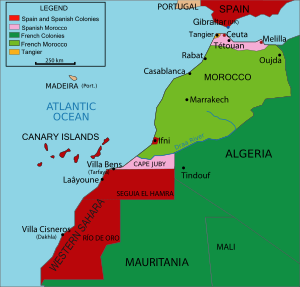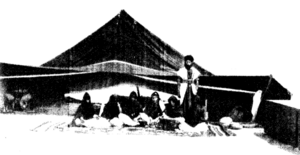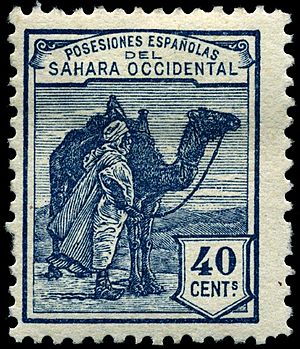Spanish Sahara facts for kids
Quick facts for kids Province of the Sahara
|
|||||||||||||||
|---|---|---|---|---|---|---|---|---|---|---|---|---|---|---|---|
| Colony (1884–1958) and Province (1958–1976) of Spain |
|||||||||||||||
| 1884–1976 | |||||||||||||||
 Green: Spanish Sahara Light grey: Other Spanish possessions Dark grey: Spain |
|||||||||||||||
| Capital | Villa Cisneros (1884–1940) El Aaiún (1940–1976) |
||||||||||||||
| Population | |||||||||||||||
|
• 1970
|
≈,239;15,600 Europeans | ||||||||||||||
|
• 1974
|
≈,239;66,925 Sahrawis | ||||||||||||||
| Government | |||||||||||||||
| • Type | Spanish colonial government | ||||||||||||||
| Governor-General | |||||||||||||||
|
• 1884–1902 (first)
|
Emilio Bonelli | ||||||||||||||
|
• 1974–1976 (last)
|
F. Gómez de Salazar | ||||||||||||||
| Historical era | New Imperialism, World War I, World War II, Cold War | ||||||||||||||
| 26 December 1884 | |||||||||||||||
| 14 November 1975 | |||||||||||||||
| 26 February 1976 | |||||||||||||||
|
|||||||||||||||
| Today part of | Morocco Sahrawi Arab Democratic Republic (Liberated territories) |
||||||||||||||
Spanish Sahara was the name for the area we now call Western Sahara. It was controlled by Spain from 1884 to 1976. This territory was one of the last places Spain held onto from its old Spanish Empire.
Between 1946 and 1958, Spanish Sahara was part of a bigger colony called Spanish West Africa. This group also included Cape Juby and Ifni. Later, these areas became separate again. Cape Juby was given to Morocco.
Spain eventually gave up Spanish Sahara. This happened because Morocco wanted the land back. Also, the United Nations pushed for countries to give up their colonies. The local Sahrawi people also wanted independence. Morocco and Mauritania both claimed the land. Mauritania later dropped its claim in 1979.
In 1975, Morocco took control of most of the area. But the Polisario Front, a group fighting for an independent Sahrawi Arab Democratic Republic (SADR), fought Morocco for 16 years. In 1991, the UN helped arrange a ceasefire. They have been trying to set up a vote for the people to decide their future. Today, Morocco controls most of Western Sahara's coast and resources.
Contents
Spain's Control of the Sahara
At the Berlin Conference in 1884–1885, European countries decided how to divide up Africa. Spain announced it would protect the coast from Cape Blanc to Cape Bojador. This happened on December 26, 1884. Spain then set up trading posts and military bases.
In July 1885, King Alfonso XII named Emilio Bonelli as the leader of the area called Río de Oro. In 1887, the area became part of the Canary Islands for military reasons. In 1886, some Spanish explorers mapped the area. This was the first scientific trip to that part of the Sahara.
When Spain arrived in 1884, the local Sahrawi people fought back. These people were Berbers who lived in oases and coastal villages. They mostly fished and herded camels. They speak a language called Hassaniya, which is an Arabic dialect.
A rebellion in 1904 was led by Shaykh Ma al-'Aynayn. France helped Spain stop this uprising in 1910. More uprisings followed, led by Ma al-Aynayn's family and other leaders.
In 1886, Spain signed a treaty with the Emirate of Adrar. This treaty said the Emirate gave the land to Spain. However, the Emirate did not actually own the land. Spain basically "invented" a claim that the Emir could easily give up.
Morocco says that the territory was part of its kingdom in 1884. They point to old treaties from the 1500s and 1700s. These treaties show that Morocco's power reached beyond Cabo Bojador. However, the International Court of Justice looked at these treaties in 1975. They said the treaties only showed loyalty between the Sahrawi people and Morocco. They did not prove Morocco owned the land.
The exact borders of Spanish Sahara were not clear until the early 1900s. Spain and France signed treaties to define them. Spanish Sahara was formed in 1924 from two Spanish areas: Río de Oro and Saguia el-Hamra. It was managed separately from other Spanish areas in Morocco.
Modern History of Spanish Sahara
After Morocco became independent in 1956, it claimed Spanish Sahara. Morocco said the land was historically part of its kingdom. In 1957, the Moroccan Army of Liberation tried to take Ifni, an area north of Spanish Sahara. Spain sent soldiers and, with help from France, took back control.
Spain tried to stop resistance by changing how people lived. They made some nomadic Sahrawis settle in towns. This increased the number of people living in cities. In 1958, Spain combined Saguia el-Hamra and Río de Oro into the province of Spanish Sahara. In the same year, they gave the Cape Juby area to Morocco.
In the 1960s, Morocco kept asking for Spanish Sahara. The United Nations agreed to add the territory to its list of places that needed to become independent. In 1969, Spain gave Ifni to Morocco, but kept Spanish Sahara.
In 1967, a secret protest group called Harakat Tahrir challenged Spanish rule. Spain stopped a protest in 1970 called the Zemla Intifada.
In 1973, the Polisario Front was formed. This group wanted an independent Sahrawi nation. Their guerrilla army grew quickly. By early 1975, Spain had lost control of most of the territory. Spain tried to create a rival political group, but it didn't work well. Spain also tried to work with tribal leaders by setting up the Djema'a. This group was made of leaders chosen by Spain, who received benefits for agreeing with Spain's decisions.
In late 1975, Spain faced strong demands for the territory from Morocco and Mauritania. This led to the Green March. In this event, 350,000 Moroccans walked several kilometers into Western Sahara. This happened even though the International Court of Justice had just given an opinion on the territory. After talks with Morocco and Mauritania, Spain pulled its soldiers and citizens out of the area.
Morocco and Mauritania then took control. Mauritania later gave up its claim after losing a war against the Polisario Front. Morocco started fighting the Polisario Front as it took over the region. After 16 years, the UN arranged a ceasefire in 1991. Today, Morocco and the Sahrawi people still disagree about who owns the territory. A vote on its future has not happened yet.
What is the Status Today?
The United Nations (UN) lists Western Sahara as a territory that has not yet been decolonized. This means it is still under international law as a militarily occupied area. It is not legally part of Morocco.
Many Moroccan settlers now live in Western Sahara. They make up more than two-thirds of the people there. Under international law, moving your own citizens into an occupied territory is against the rules. This is stated in Article 49 of the Fourth Geneva Convention.
The UN has been working to hold a vote for the Sahrawi people to decide if they want independence. But this vote has not happened yet. The African Union (AU) and many governments see the territory as the independent state of the Sahrawi Arab Democratic Republic (SADR). This government-in-exile is supported by the Polisario Front.
Images for kids
-
Villa Cisneros Fortress and Aircraft Booth, year 1930 or 1931
-
Spanish barracks in El Aaiún in 1972
See Also
 In Spanish: Sahara español para niños
In Spanish: Sahara español para niños
- List of colonial governors of Spanish Sahara
- International Court of Justice Advisory Opinion on Western Sahara
- History of Western Sahara
- Moroccan Army of Liberation
- Southern Provinces
- Tiris al-Gharbiyya
- Sahrawi Arab Democratic Republic
- Spanish West Africa








